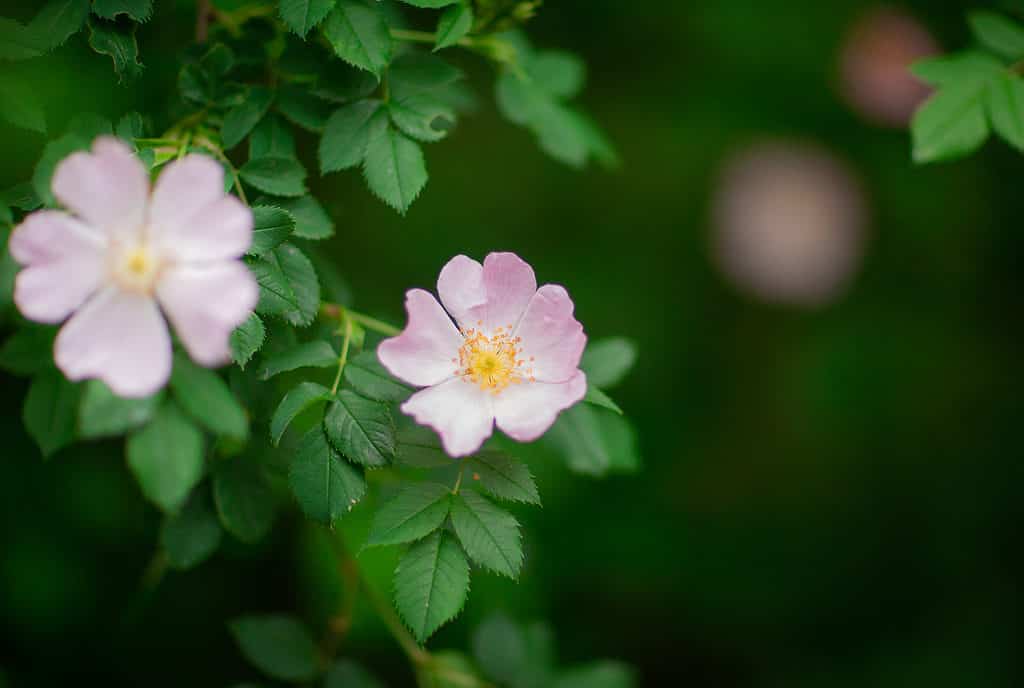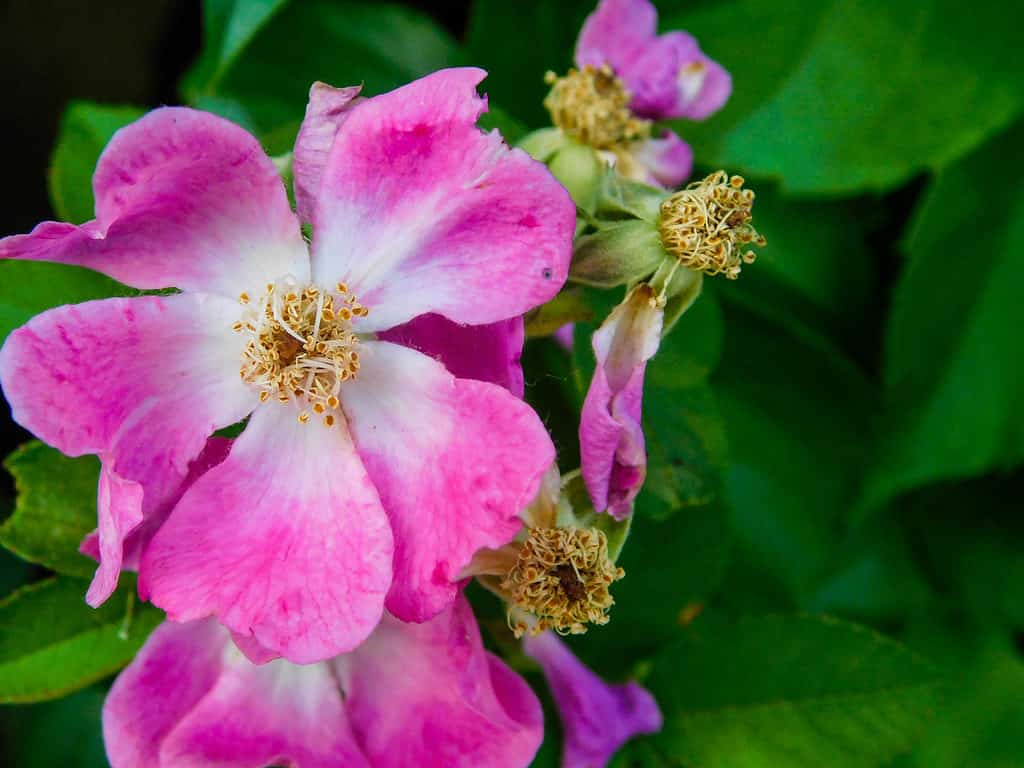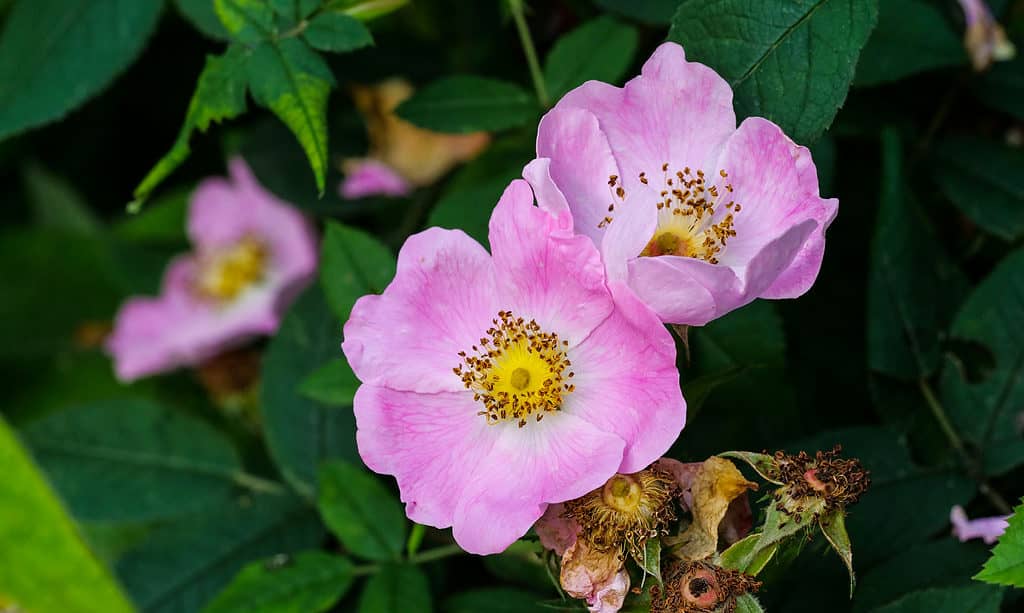If you’re looking to grow roses in Tennessee, you should consider planting some of the state’s native species. Although they are less sophisticated in appearance than many garden cultivars, their simplicity is their true beauty.
When most people think of roses, they probably picture pristine cut flowers and rigorously maintained gardens full of large, fragrant rose bushes. Most of the time, they’d be right — people have spent centuries breeding roses for bloom size, color, and fragrance. As a result, there are thousands of showy rose cultivars available for purchase today.
All of those cultivars are descended from humbler wild roses, however — species roses, as they are called. While these progenitor species look quite different from most garden cultivars, they are usually much easier to grow. In fact, Tennessee is home to multiple species of wild roses that have evolved to grow happily all across the state.
4 Species Roses That Thrive in Tennessee
Wild roses are quite a bit smaller and simpler than their heavily cultivated relatives. They are always single, always contain five petals, and are most commonly pink or white. However, although they are simpler, they are much more vigorous growers and oftentimes require significantly less maintenance than their garden-variety counterparts. In fact, most people say that these roses “thrive on neglect”.
If you want to grow roses in Tennessee, there’s certainly a species rose that fits your gardening needs. They are great to grow for beginning gardeners and experienced rosarians alike. Below, we’ll talk about four species roses that have evolved to grow particularly well in our state. Whether your soil is rocky and infertile or wet and shaded, wild roses will gladly make it their home.
Pasture Rose (Rosa virginiana)
Hardy and fast-growing, the pasture rose is great for gardens with plenty of space. This native rose species is a woody perennial, returning year after year to bear its long-lived pink and yellow summer flowers.
Overall, the bush will usually grow to between 4 and 6 feet in height and about as wide, so make sure to give it ample space to spread out. Though it is uncommon, bushes of this species may reach up to 10 feet in height in ideal growing conditions.
This species prefers planting sites with full sun. Although it can tolerate shade, open spaces and good sun exposure can help prevent blackspot and powder mildew. The best type of soil for these roses is well-draining and slightly acidic, but it can adapt to a range of conditions.
In the late summer, the pasture rose’s many flowers will give way to red fruits called rosehips. These are high in vitamin C and deliciously edible. People often make them into soups, juices, jams, and teas, but you can also eat them raw once they have fully ripened. Be sure to remove the seeds, though, as the hairs can be irritating when consumed.

The Virginia rose blooms in midsummer, and the flowers last unusually long. When fertilized, they give way to delicious red rosehips later in the season.
©iStock.com/Vincent Ryan
Swamp Rose (Rosa palustris)
The swamp rose, as its name might suggest, prefers wet soils that are rich in organic matter. While it won’t grow when submerged for weeks on end, it can handle periodic flooding and soils that remain saturated. If you’ve got a low area in your yard where other plants struggle to grow, this species of rose is likely a good planting choice. These bushes can also help cover and add stability to drainage ditches.
On average, the entire bush will reach heights of 3 to 6 feet. The pinnate leaves are dark green and hang from red, gracefully arching branches. They make for great living fences and privacy hedges in areas that would not normally be conducive to the growth of other plants. In the summer, these roses will put forward a multitude of pale pink or white roses, up to 2 inches in diameter, with bright, golden centers. They are quite fragrant and do an excellent job of attracting native pollinators.
In addition to producing edible hips in the fall, the swamp rose will shed its leaves alongside local deciduous trees. Expect leaves to turn deep, gorgeous shades of red before falling. If you plan on harvesting the rosehips, take care to avoid the characteristic curved prickles that line the plant’s stems.

Two swamp roses with light pink petals growing from a green bush. This is one of the best roses in Tennessee for growing in the wet, disturbed soils that are becoming increasingly common across the state.
©HBRH/Shutterstock.com
Climbing Prairie Rose (Rosa setigera)
The climbing prairie rose is another wild species that does well in large spaces. It is a strong climber, using its robust thorns to take hold of and hoist itself over nearby objects. Because of this trait, gardeners often train it to grow vertically along trellises, fences, or pergolas. It can stretch to heights of up to 15 feet! As a bonus, it propagates quite easily, forming adventitious roots from any of its long, arching stems that remain in contact with the ground.
This species is not particular about its soil conditions and can grow in soils that many hybrid cultivars would not tolerate. The climbing prairie rose will gladly make its home in infertile, compacted soils and along roadsides. Because of its strong ability to spread and cover the ground, it can be a great help in reestablishing areas with erosion problems. The wild prairie rose, while versatile, does not do well in overly wet soils and does not tolerate long periods of drought.
The climbing prairie rose blooms in the summer. Its showy, five-petaled flowers are a deep vibrant pink that fades to white with age. It blooms from its new wood, which means that sections pruned in early spring will bear flowers later in the season. Like other wild roses, the flowers are great attractors of native pollinating insects, like the common bumblebee, and non-native ones like the European honeybee, Apis mellifera. The red rosehips that the plant produces serve to attract birds and small mammals who take advantage of them as a source of food.

The climbing prairie rose produces beautiful, fragrant flowers and can be trained to climb to great heights!
©iStock.com/Wirestock
Carolina Rose (Rosa carolina)
The Carolina rose is one of the most widely-distributed native roses in Tennessee. It grows statewide in a variety of soil conditions, from infertile rocky or sandy soil to clays and loams. No matter where you live in the state, you’re sure to have success growing this wonderful wild rose.
Unlike some of the other wild species, the Carolina rose is very well-suited for growing in small spaces. This species is tolerant of shade but produces the most leaves and flowers when sunlight is unrestricted. Strong sunlight and good air circulation help prevent the fungal diseases that roses are naturally susceptible to.
Bushes of this species average heights of only 2 to 3 feet with horizontal spreads of a similar size. Great for producing short, living fences or planting along borders, they are very fast growers and can quickly form dense, flowering thickets. It is best to prune this species in the late winter while the plant is still bare or in the early spring as growth is just beginning. Its two-inch wide, ruffled flowers are a delicate, pale pink and begin to appear in May.
These roses produce what is undoubtedly the most impressive fall display of any of the wild species. At the end of the growing season, the abundant foliage turns from dark green to an array of yellows, oranges, and reds.

The Carolina
rose shrub
has erect grayish-brownish stems, needle-like thorns, and fragrant flowers.
©Brookgardener/Shutterstock.com
The photo featured at the top of this post is © Kimberly Boyles/Shutterstock.com
Thank you for reading! Have some feedback for us? Contact the AZ Animals editorial team.






